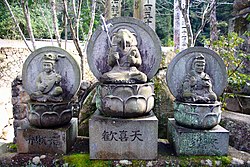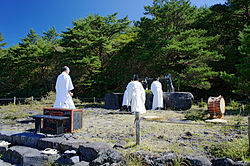

Religion in Japan is manifested primarily in Shinto and in Buddhism, the two main faiths, which Japanese people often practice simultaneously. According to estimates, as many as 70% of the populace follow Shinto rituals to some degree, worshiping ancestors and spirits at domestic altars and public shrines. An almost equally high number is reported[6] as Buddhist. Syncretic combinations of both, known generally as shinbutsu-shūgō, are common; they represented Japan's dominant religion before the rise of State Shinto in the 19th century.[7]
The Japanese concept of religion differs significantly from that of Western culture. Spirituality and worship are highly eclectic; rites and practices, often associated with well-being and worldly benefits, are of primary concern, while doctrines and beliefs garner minor attention.[8] Religious affiliation is an alien notion. Although the vast majority of Japanese citizens follow Shinto, only some 3% identify as Shinto in surveys, because the term is understood to imply membership of organized Shinto sects.[9][10] Some identify as "without religion" (無宗教, mushūkyō), yet this does not signify rejection or apathy towards faith. The mushūkyō is a specified identity, which is used mostly to affirm regular, "normal" religiosity while rejecting affiliation with distinct movements perceived as foreign or extreme.[11][12]
- ^ Japan - Country. CIA, Government of the United States.
- ^ a b "Population Estimates Monthly Report - December 1, 2020 (Final estimates)".
- ^ CIA World Factbook:[1]
- Shinto: 70.5%
- Buddhism: 67.2%
- Christianity: 1.5%
- Other: 5.9%
Percentages calculated using the official total population figure of 126,088,000 as of the end of 2020.[2]
- ^ "Japan - The World Factbook". www.cia.gov.
- ^ 宗教年鑑 令和3年版 [Religious Yearbook 2021] (PDF) (in Japanese). Agency for Cultural Affairs, Government of Japan. 2021.
- ^ Population figures from the Agency for Cultural Affairs Religious Yearbook 2021, as of the end of 2020, are as follows:[5]
- Shinto: 87,924,087
- Buddhism: 83,971,139
- Christianity: 1,915,294
- Other: 7,335,572
Percentages calculated using the official total population figure of 126,088,000 as of the end of 2020.[2]
- ^ Reischauer, Edwin O.; Jansen, Marius B. (1988). The Japanese today: change and continuity (2nd ed.). Belknap Press of Harvard University Press. p. 215. ISBN 978-0-674-47184-9.
- ^ Kisala, Robert. 2006. Japanese Religions. Pp. 3-13 in Nanzan Guide to Japanese Religions, ed. Paul L. Swanson and Clark Chilson. Honolulu: University of Hawaii Press.
- ^ Engler, Price. 2005. p. 95
- ^ Williams, 2004. pp. 4-5
- ^ Kawano, Satsuki. 2005. Ritual Practice in Modern Japan: Ordering Place, People, and Action. Honolulu: University of Hawaii Press.
- ^ LeFebvre, J. (2015). "Christian wedding ceremonies: 'Nonreligiousness' in contemporary Japan". Japanese Journal of Religious Studies, 42(2), 185-203